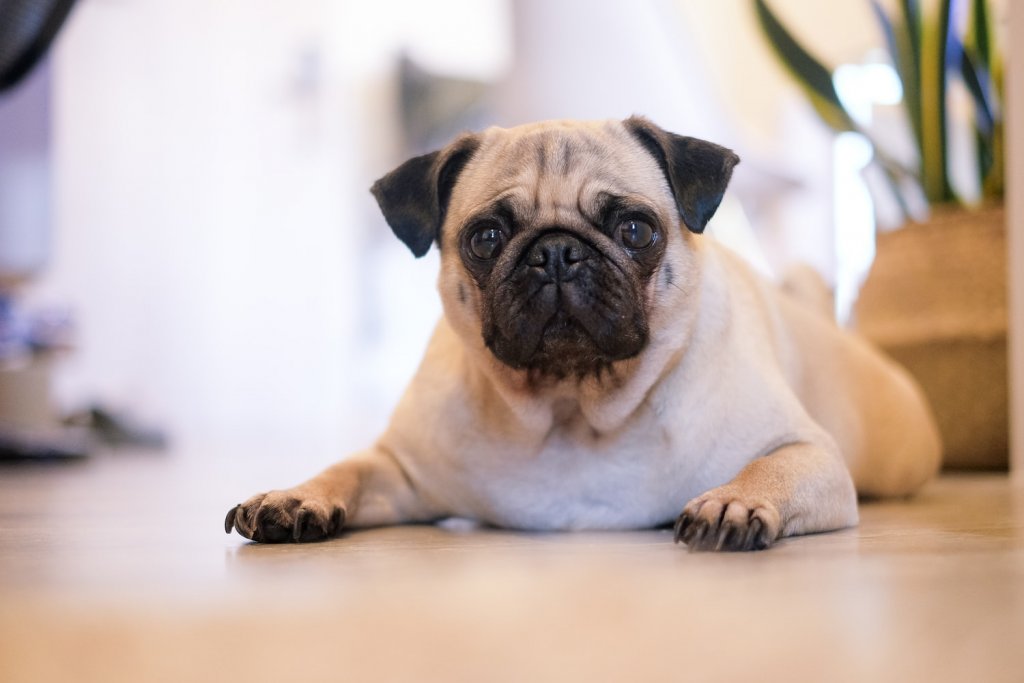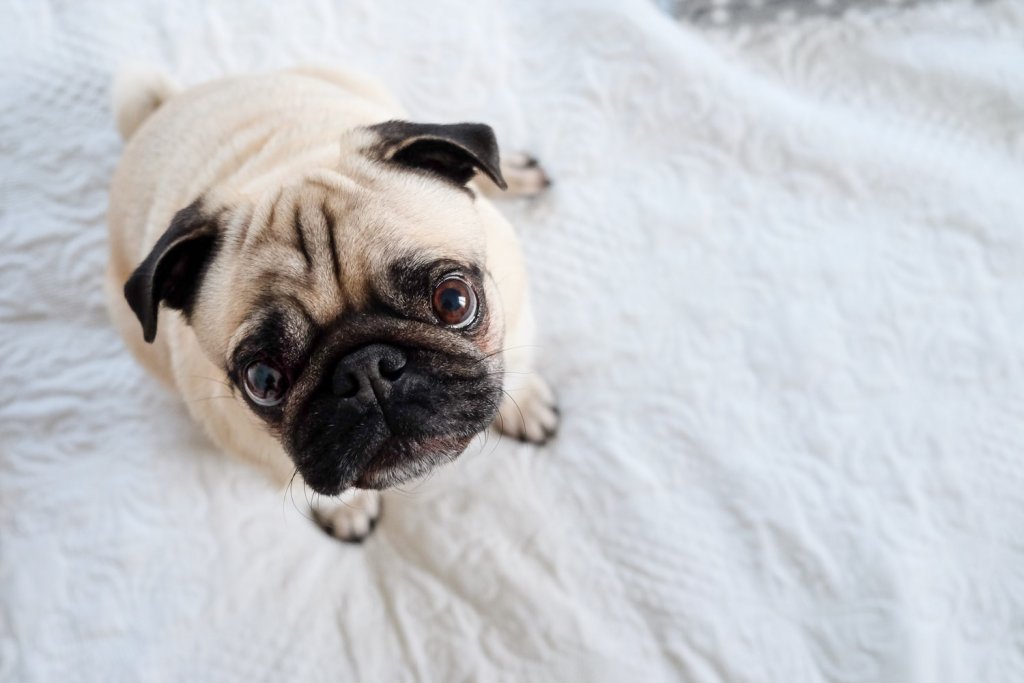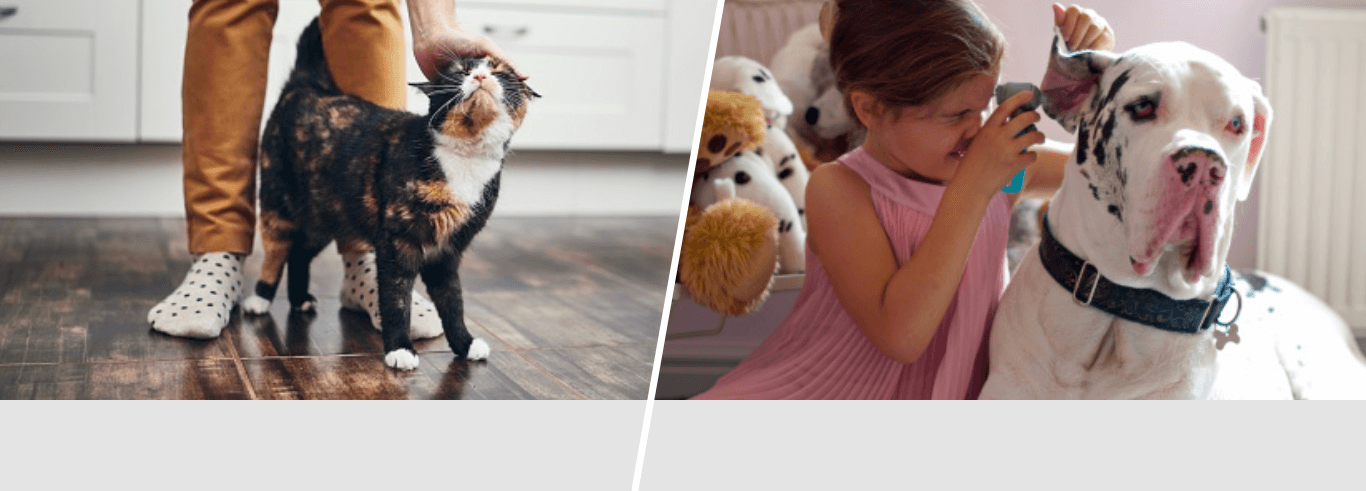Everything you need to know about pugs
The pug breed is a small but sturdy breed known for their adaptability, big personalities and human-like facial expressions. Throughout history, pugs have been very popular with royalty around Asia and Europe and rose to prominence during the Victorian era.
Thinking of adopting a pug, or simply want to know more? Here’s everything you need to know before adding the breed to your family.
Pug fact file
Content provided from Vetstream’s Vetlexicon
| Breed Name | Pug (Canis lupus familiaris) |
|---|---|
| General Appearance | Round face, short nose, wrinkled forehead, curled tail |
| Temperament | Happy, lively and stubborn |
| Gait/Movement | Strong forelegs, free-moving hind legs and a slight roll of the hindquarters |
| Coat | Smooth, short and soft |
| Colour | Black, silver, apricot or fawn, with black muzzle and ears |
| Size | Height: 25 cm – 30 cm Weight: 6.3 kg – 8.1 kg |
| Lifespan | 12 – 15 years |
What does a pug look like?
Originally bred to be a lap dog, these small but sturdy dogs are known for their large round heads, large, protruding eyes, short noses and deep and distinct face wrinkles. These wrinkled brows also result in very humanised facial expressions like happiness, curiosity and surprise.
Pugs come in three colours: silver, apricot with a black muzzle and ears or all black. They also have high set, tightly curled tails and fine, smooth, glossy coats.
What is a pug’s personality like?
Pugs are known for their stubborn personalities and are often difficult to train. They carry themselves with dignity and play well with others but are also happy being the only pooch in your family.
These dogs are also incredibly adaptable and make a great house pet. They can be happy in the city or the countryside and make great companions for both children and older people because of their sturdy bodies and loving nature.
If you’re thinking of getting a pug puppy, they love affection and crave human attention, getting heartsick when ignored. Pugs may be playful, but as a typically sedentary dog, they are happy to just sit in your lap or receive a nice cuddle.

How to look after a pug
The first step in learning how to care for a pug isn’t difficult – show them a lot of love and affection.
Generally, they’re not great watchdogs as they prefer to greet people with a wagging tail and have very outgoing temperaments, so they enjoy socialising. It is typically easy for pugs to get along with your other pets, making them a great addition to your family.
Pugs love their food and will overeat if you let them. The breed is prone to becoming overweight, so it is important to monitor their diet and exercise carefully.
Due to their flat faces, pugs don’t do well in the heat and can overheat quite easily. Mild climates are best for them, making the UK a perfect home for your new furry friend.
Pugs have short fur, but they have what is called a double coat. This means their fur consists of two layers, one short and woolly in texture and the topcoat (or ‘guard hairs’) a bit longer. This also means that pugs shed quite a lot and require a lot of grooming. Brushing their coat as regularly as every three days with a soft bristle comb can help this.
Bath time with your pug
Pugs should be bathed once every three to four weeks. You should however clean their ears, eyes, and in between their wrinkles multiple times a week. It is important to choose a shampoo that’s hypoallergenic, mild in scent and that doesn’t dry out your pooch’s fur or irritate their skin.
Their wrinkles, as adorable as they may be, are prone to yeast infections. To keep a pug’s wrinkles dry and clean you should carefully wipe down each skin fold with a fragrance-free pet grooming wipe.
How much exercise does a pug need?
In terms of fitness, pugs only need an hour of exercise every day so don’t require a large garden to play in since they are so small. However, this is a lively and intelligent breed, so pugs do need both physical and mental stimulation throughout the day.
Pugs are a brachycephalic breed and prone to heat sensitivity and should be observed for heatstroke during hot weather. Your pug should not be exercised during the hottest part of the day, so exercising either early morning or late evening time is advisable.
When your pug is indoors, it’s good to play mental games with them to keep them entertained and also to ensure they won’t overeat.

How much does a pug cost?
The average cost of a pug in the UK ranges from £800 to £1,500.
The big price range is largely due to differing demands depending on fur colour, size, and age. As puppies are more in demand, they are more expensive. This also applies to teacup pugs; these small dogs are highly sought after for their small frames. The apricot-coloured pugs with black muzzles and ears are the most popular coat colour and as a result, breeders will typically charge more for them as well.
For pedigree dogs such as pugs, it is important to find a reputable breeder. This means your dog will have been bred ethically and for good health rather than trendy physical features.
What health problems can a pug experience?
Content provided from Vetstream’s Vetlexicon
There are some common health conditions linked to this breed:
Brachycephalic airway obstruction syndrome (BAOS)
In short-nosed breeds, the tissues in the nose and throat are squashed. This causes folds and wrinkles which obstructs the airways. Affected dogs will be reluctant to exercise as they can’t take in enough oxygen.
They will breathe heavily and noisily. Pain when swallowing and regurgitating food can also be symptoms. Surgery to remove the excess tissue is the only way to treat BAOS. The problem can be managed by keeping the dog at a healthy weight.
Hemivertebrae
A hemivertebra is a deformed vertebra (backbone), which is caused by the fusing of two or more vertebrae, or it develops unevenly. This causes a wedging effect that twists and compresses the spine. Signs of the condition include weakness of hind limbs, pain and incontinence.
Some dogs can live with hemivertebrae and not experience any of these symptoms. Rest and anti-inflammatories can be helpful for mild cases. Severe cases will need surgery to relieve the compression on the spinal cord.
Keratoconjunctivitis (Dry eye)
This condition develops when there is a problem with the tear glands. A lack of tears causes dry eyes, which are sore and often become infected or damaged. Treatments vary but they all aim to prevent the eyes from drying out. If left untreated, scarring and pigmentation will occur, which can lead to blindness.
Luxating patella
Luxating patella is where the kneecap is unstable and doesn’t slide into the correct place. Affected dogs will hop rather than use the affected leg and are prone to other knee-related injuries. In some cases, the problem is temporary, but usually surgery is needed to correct the alignment.
Looking to buy a new Pug? It’s important to protect your new family member with Argos Pet Insurance provided by Pinnacle Insurance Ltd. Explore our Pug insurance policies today.
 Sorry, our lines are now closed
Sorry, our lines are now closed



